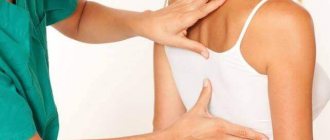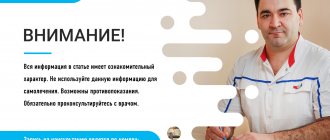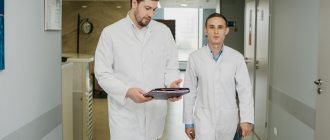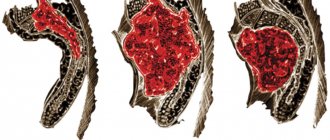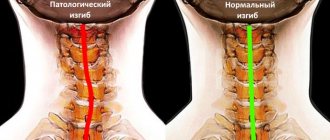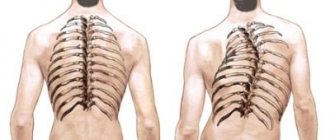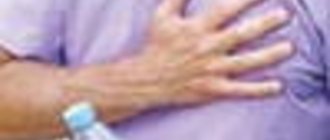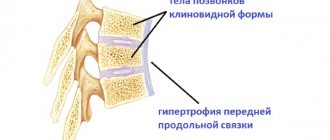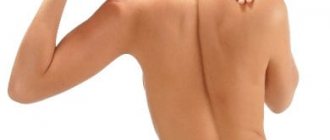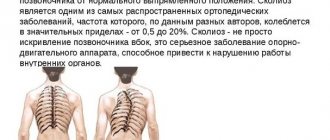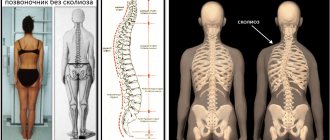Scoliosis 1st degree is the initial stage of the development of pathology, which is characterized by a lateral deviation of the vertical axis of the spine. If you do not start timely treatment for grade 1 scoliosis, the disease will progress and lead to much more serious consequences than at this stage.
Depending on the direction of the primary scoliotic curve, it is customary to distinguish:
- left-sided scoliosis 1st degree;
- right-sided scoliosis 1st degree.
Spinal scoliosis of the 1st degree is characterized by a curvature angle of no more than 10°, so visually the asymmetry is almost invisible. The stoop and position of one shoulder higher than the other are striking. You can undergo a course of treatment for grade 1 scoliosis at the CELT multidisciplinary clinic. In order to become our patient, it is not necessary to have a residence permit in the capital - just contact the reception desk.
At CELT you can get advice from a neurosurgeon.
- Initial consultation – 3,000
- Repeated consultation – 2,000
Make an appointment
Etiology
Pathology such as scoliosis refers to deformations of the growth period. It occurs during the growth of the body in adolescence. In about 80% of cases of scoliosis of the 1st degree of the lumbar and other parts of the spine, the cause is unknown. This type of scoliosis is called idiopathic. Most often it occurs in girls during intensive skeletal growth.
As for the remaining 20%, the reasons that caused the appearance of the pathology include the following:
- congenital vertebral deformities;
- pathologies of the neuromuscular system;
- connective tissue pathologies;
- bone metabolism disorders;
- injuries;
- surgical interventions.
MRI of the spine
- Cost: 16,000 rub.
More details
Symptoms and signs of pathology
Basically, left-sided scoliosis does not cause pain - they are characteristic only of the last stages, when the curvature is observed visually. The initial stages of the disease may manifest themselves with the following symptoms:
- asymmetrical shoulders, hips;
- visible curvature of the spinal column;
- head not centered in relation to the body;
- visually different lengths of the upper or lower limbs;
- ribs protruding from one side.
As a rule, pain and neurological disorders that occur in the last stages of left-sided scoliosis indicate acquired diseases: osteochondrosis, spondylosis, etc.
Clinical manifestations
Scoliosis 1st degree of the thoracic spine is characterized by:
- mildly manifested aching back pain that occurs after physical exertion;
- lateral curvature, which is very difficult to determine visually.
Due to such minimal symptoms, the patient at this stage rarely seeks professional medical help. And this is very bad, because the result depends on how timely the treatment is.
Rachiocampsis
Treatment of scoliosis
Treatment of lateral curvatures of the spine can be conservative or surgical. Conservative therapy programs include specially designed exercise therapy complexes, breathing exercises (according to Schroth or similar programs), corsets, reclinators, physiotherapeutic procedures and massage.
- Physiotherapy
. When the angle of deformation is up to 15 degrees, specialized gymnastics is prescribed. Exercises are selected individually; in the initial period they should be performed under the supervision of an instructor in order to master the correct technique. The goal of gymnastics is to strengthen the back muscles and create a good muscle corset. - Wearing a corset
. When the angle of curvature of the spine is 15-25 degrees, exercise therapy classes are supplemented by wearing corsets. At an angle of up to 20 degrees, the corset should be used at night, more than 20 degrees - most of the day and night (at least 16 hours a day). Corrective corsets Milwaukee, Chenault and their analogues are used. The wearing period is 6 months or more. As the child grows and the deformity decreases, the corsets are replaced. Corrective devices can eliminate not only lateral and anteroposterior curvature, but also rotation of the spine. - Massage
. Therapeutic massage for scoliosis helps strengthen the back muscles and normalize lymph and blood circulation. A course of treatment consisting of 15-20 sessions is carried out 2-3 times a year. - Physiotherapy
. Patients are prescribed hydrotherapy, heat therapy (paraffin, ozokerite) and electrical stimulation.
Indications for surgery for scoliosis are determined individually and depend on the age of the patient, the type and location of the curvature and some other factors. The generally accepted criteria for the need for surgical treatment are a curvature of 45-70 degrees as measured by Cobb in combination with the ineffectiveness of conservative treatment, persistent pain, steady progression of scoliosis, impaired pulmonary and cardiac function. Operations according to Chaklin, Tsilke, Dubusset, Harrington and others are used.
The essence of all surgical techniques is to remove and hold the spine in the correct position with the help of metal structures. In this case, the fixed part of the spine loses mobility. Surgical interventions are performed from an anterior or posterior approach. To fix the spine, metal rods are used, which are attached to the vertebrae with screws or hooks. Subsequently, the fixed vertebrae become fused into a single block.
Treatment of kyphosis
Therapeutic tactics depend on the cause of the curvature of the spine, the degree of kyphosis, the patient’s age, his condition, and other factors. With 1-2 degrees of kyphosis, a complex conservative therapy program is drawn up, including exercise therapy, massage, breathing exercises, physiotherapy, mud therapy and reflexology.
In case of grade 3-4, dysfunction of internal organs, severe pain, rapid progression of spinal curvature, significant cosmetic defect and the presence of severe neurological disorders, surgical operations are performed. Treatment consists of correcting the bend using special metal structures fixed to the vertebrae with hooks or screws. Sometimes it is necessary to perform several operations to achieve the desired effect.
Treatment of lordosis
Treatment tactics depend on the cause and degree of spinal curvature, the patient’s age, his state of health and other factors. If possible, therapeutic measures are taken to eliminate the cause of the deformity. A complex of exercise therapy, massage, heat and hydrotherapy is prescribed. Some patients are recommended to wear a bandage.
Reviews of doctors providing the service – Scoliosis 1st degree
In 2000, Andrei Arkadyevich performed spinal surgery on me.
Four days in the clinic and I have been living a full life for 20 years without restrictions on movement and I remember with gratitude Dr. A.A. Khodnevich. God bless him. And in 2000 he could walk no more than 10 meters. Read full review Viktor Alexandrovich
20.05.2020
Low bow to Alexander Semenovich Bronstein and Andrei Arkadyevich Khodnevich. I arrived at CELT on July 2, 2021 with extreme pain that I endured for 10 days. Hernia C6-C-7. I was given two blockades in Ivanovo, about 9 complex IVs, I lost 6 kg in a week and was in a panic, I didn’t see a way out and nothing happened to me... Read full review
Elena Nikolaevna L.
20.10.2019
Scoliosis
Scoliosis is a curving deformation of the spinal column in the lateral projection (to the right or left of the vertical axis). Most often it is formed in childhood (in infancy and ages from 3 to 5 years) or in the period from 18 to 25 years.
The severity of scoliosis is determined by the angle of deviation of the spine. To measure it, X-rays are taken in standing and supine positions.
The severity of the symptoms of the disease is directly related to the degree of scoliosis: the greater the curvature, the greater the load on the internal organs and systems.
There are 4 degrees of scoliosis:
First degree scoliosis is expressed as a deviation from the norm of up to 10 degrees. The disease is characterized by a slight stoop and subtle asymmetry in the position of the shoulders and shoulder blades; when bending forward, one shoulder blade protrudes more noticeably than the other. In a number of countries, this stage of scoliosis is considered a variant of the norm, a physiological feature.
Scoliosis of the second degree is characterized by a deviation of the spine from the axis of up to 25 degrees. The patient has obvious asymmetry of the shoulders, shoulder blades, and buttocks. When the body is tilted, the vertebrae stand out unevenly, one shoulder blade protrudes strongly, and there are costal protrusions. The muscle roll is easily palpable, convex on the chest side, concave on the lumbar side. Painful sensations are not expressed. Scoliosis of the second and subsequent degrees requires mandatory treatment; the pathology can progress quickly.
Scoliosis of the third degree is characterized by a curvature of the spine of 26-50 degrees. The patient's posture is impaired, the shoulders and pelvis are distorted, a rib hump is formed, and one leg may appear shorter. Severe deformations of the chest and spinal column lead to compression of internal organs, which is dangerous to health. The condition is accompanied by pain, restrictions in movement, digestive problems, etc.
The fourth degree of scoliosis is the most severe, the scoliotic angle is 50 degrees or more. The patient's spine, chest and pelvis are deformed, a rib hump is formed in front and behind. Due to compression, all internal organs and systems cease to function normally, a person is plagued by pain and numerous pathological manifestations of the heart, lungs, gastrointestinal tract and urinary system.
1 Massage for scoliosis
2 Massage for scoliosis
3 Massage for scoliosis
Causes of scoliosis
Poor posture in childhood is one of the main provoking factors in the development of scoliosis.
Other common reasons include:
- cerebral palsy;
- congenital vertebral deformities;
- rickets, polio;
- vertebral injuries, including birth injuries;
- injuries to the pelvic bones, legs;
- diseases of muscles, connective tissues;
- osteoporosis;
- spinal tumors;
- obesity, etc.
What are the risks of back scoliosis?
With cervical scoliosis, compression of the arteries of the spine occurs, which adversely affects blood circulation in the brain. The patient suffers from dizziness, headaches, and cognitive impairment.
Thoracic scoliosis is dangerous because it compresses the chest and abdominal cavity, causing damage to internal organs. Their improper functioning is fraught with numerous malfunctions in the body.
Lumbar scoliosis is characterized by deformation and displacement of the pelvic bones, which means inevitable lumbar pain, problems with the kidneys, bladder and intestines, and sexual dysfunction.
Treatment of scoliosis
Success in the treatment of scoliosis directly depends on timely identification of the problem and early contact with a qualified specialist.
The doctor selects a treatment regimen individually for each patient, depending on the degree of the disease.
Correction of first degree scoliosis : as a rule, physical therapy and massage for scoliosis of this degree are the most effective methods.
For the treatment of scoliosis of the second and third degrees, wearing a special corset, electrical myostimulation, exercise therapy, therapeutic massage, and swimming may be recommended. Drug therapy may include the prescription of anti-inflammatory drugs, muscle relaxants, vitamins, etc.
4th degree of scoliosis : if conservative treatment methods are ineffective, surgical straightening of the spine is recommended, followed by long-term rehabilitation and wearing a corset.
Causes of the disease
The main cause of lateral curvature is uneven distribution of the load on the spine and incorrect body position during prolonged sitting.
Depending on the causes, scoliosis is divided into the following types :
| Congenital: | Acquired: | |
| This is a curvature of the spine that occurs with certain congenital anomalies in the development of the spine (fusion of the vertebrae, the presence of hemivertebrae, etc.). | Subtype | Causes |
| Rachitic | The cause is rickets. | |
| Dysplastic | Develops due to disruption of the ossification process of the vertebrae. | |
| Paralytic | Appears due to cerebral palsy, polio, partial paresis of the back muscles. | |
| Idiopathic | The causes of its occurrence are unknown, it occurs frequently and progresses rapidly. | |
| School | This type is the most common. The reasons are incorrect position of the spine with a poorly developed muscular system. Curvature can be caused by uncomfortable school furniture, the wrong choice of briefcase, physical inactivity, or a child’s weakened immune system. Therefore, scoliosis is often called a school disease. | |
Thus, the following provoking factors of the disease can be identified::
- Physical inactivity.
- Overweight.
- Back injuries.
- Rickets.
- Infectious diseases (ostiomyelitis)
- Cerebral palsy.
- Rheumatism.
- Flat feet.
- Tuberculosis of bones.
- Pregnancy.
- Hernias, protrusions.
- Spinal tumors.
- Congenital anomalies of the formation of the spine.
- Heredity.
Advantages of treatment at Elena Malysheva’s clinic
The medical center will provide you with high-quality medical care, comfortable conditions, friendly attitude, attention and care.
If necessary, the doctor will recommend consulting with other specialists. Are you suffering from chest and back pain? Do not self-medicate, as this can lead to the development of dangerous complications, irreversible changes and disability. Come to Elena Malysheva's clinic. A timely visit to a doctor will allow you to quickly eliminate the pathology and return to your normal lifestyle.
Appointments can be made by telephone. You can also order a call back or fill out the feedback form.
Treatment of thoracic scoliosis
For scoliosis therapy to be successful, it is necessary to eliminate the cause of the pathology, correct the curvature of the spine and consolidate the result. For each patient, the specialist individually selects treatment methods, which may include:
- medications - eliminate changes in the vertebrae, restore their structure;
- physiotherapeutic procedures - strengthen the immune system, improve overall health;
- massage and manual therapy - activate blood circulation, providing nutrition and oxygen to the vertebrae, normalize metabolic processes, reduce curvature of the spine;
- physical therapy - exercises strengthen the muscle corset, straighten posture, restore the proper functioning of internal organs;
- traction - the vertebrae gradually return to their place;
- corset therapy - reduces the load on the thoracic region.
In severely advanced cases, when conservative methods do not produce results, the doctor recommends surgery, during which a metal structure is temporarily installed to straighten the spine.
The essence of pathology, degrees and stages
Scoliosis is a deviation of the spine from its axis to the right or left. It begins to form due to different pressure on the vertebral discs. Due to the resulting asymmetry, the axis of the spine shifts with simultaneous vertical rotation of the vertebrae. As a result of this displacement, soft tissue irritation begins and pain occurs. Depending on the side of the curvature, lumbar scoliosis can be right- or left-sided .
It is necessary to differentiate the disease from postural disorders, in which only a displacement of the axis of the spinal column is observed without rotation of the vertebrae.
Lumbar scoliosis has four degrees, depending on the angle of curvature:
- 1st degree . The angle of curvature is 5-10 degrees.
- 2nd degree . Angle - 11-25 degrees.
- 3rd degree . The angle of curvature is 50 degrees.
- 4th degree . The angle is greater than 50 degrees.
Scoliosis of the lumbar region can develop in parallel with curvature of the spine in the thoracic region
The development of scoliosis occurs in three stages, depending on the patient’s age.:
- Up to 8 years old . At this age, the cartilaginous structure predominates in the vertebrae.
- 8-14 years old . Ossification of the vertebral processes and arches begins.
- 14-18 years old . The formation of the spinal column is completed, its structure is preserved until the end of life.
Pathological curvatures can be corrected as long as the spine still has cartilaginous parts. After 18 years, lateral deformities are difficult to treat.
